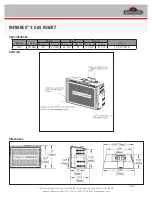
24
ENGLISH
Ignition with the combustion chamber
cold.
1. Check that the existing ash bed is not too high. If the
ash bed becomes too high there is a danger that hot
embers may fall out of the combustion chamber when
the combustion chamber door is opened to add wood.
2. Move the lever for regulating the air valve to the
“fully open” position. There will be an intense flow of
combustion air to the wood in the combustion chamber
allowing quick and efficient combustion.
3. Place the wood in the combustion chamber without
packing it excessively. Place an ignition unit among the
logs, and ignite. Never use ignition products such as
petrol, alcohol and the like.
4. At this point, close the door and monitor for a few
minutes. If the fire should go out, open the door slowly,
place another ignition unit among the logs and ignite
it again.
Adding wood when the combustion
chamber is hot
When is the right time to add wood? When the fuel
has almost finished and is in hot embers. Using the
glove provided, open the hinged door slowly (to avoid
the creation of air vortices which could cause smoke
to leak out). Add the desired quantity of wood into the
combustion chamber, placing it on top of the existing
embers (within the quantity limits indicated in the
technical sheet).
Operation with low initial draught
In order to draw in the air for combustion and to
discharge the smoke, the combustion chamber needs
the draught created by the flue.
If the draught is weak, initially light a “start up” fire
using smaller pieces of ignition material.
Once the correct level of draught has been restored,
you can add the fuel.
As with all appliances, a wood appliance heats up and
cools down during the various operating stages. This
causes normal levels of expansion. This expansion
may cause slight settling noises that cannot be used
as a cause for complaint.
FUEL
The product is designed for burning wood pellets or
logs. Use dry wood logs (max. 20% humidity)
Using damp wood will make the product and flue dirty,
risk the release of smoke and provide a lower heat
output.
Each type of wood has different properties that
influence the output of the combustion process.
The data given in this manual refers to the wood used
during certification.
Generally speaking, wood has a calorific value of
approximately 4.5 kWh/kg. When freshly cut it has a
calorific value of approximately 2 kWh/kg.
Generally speaking, we recommend using beech, elm
or other class A1 woods in accordance with UNI EN
ISO 17225-5.
Avoid the prolonged use of woods rich in aromatic oils
(e.g. eucalyptus). This may deteriorate the cast iron
components.
Use the recommended quantities of wood.
Overloading may lead to overheating, causing the
following damage:
• possible buckling of the internal parts;
• possible irreversible alterations in the colour of
the paint on the metal parts, for which neither
Edilkamin nor the retailer can be held responsible.
For reasons of safety and environmental compatibility,
DO NOT burn, among other, plastic, painted wood,
coal or bark. Do not use the product as an incinerator.
The use of these fuels will invalidate the warranty.
First ignition procedure
• Make sure you have read and understood this
manual
• Remove all flammable materials from the appliance
(manuals, labels, etc.). Make sure you remove
the labels on the glass. They would irreparably
damage the glass if they melted.
To light the fire in the combustion chamber, always use
smaller pieces of wood. Use larger pieces of wood to
feed the fire once it has started.
Place the wood on the combustion grille.
On first ignition, there may be a slight smell of paint,
which will disappear in a short time.
Always use the glove provided to touch
any hot parts. Avoid direct contact with
hot parts.
USER INSTRUCTIONS
®





































